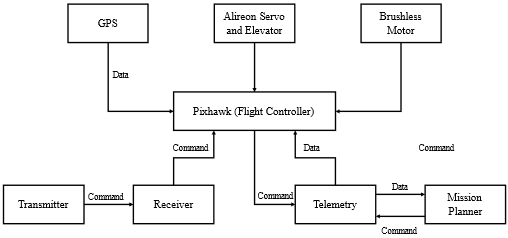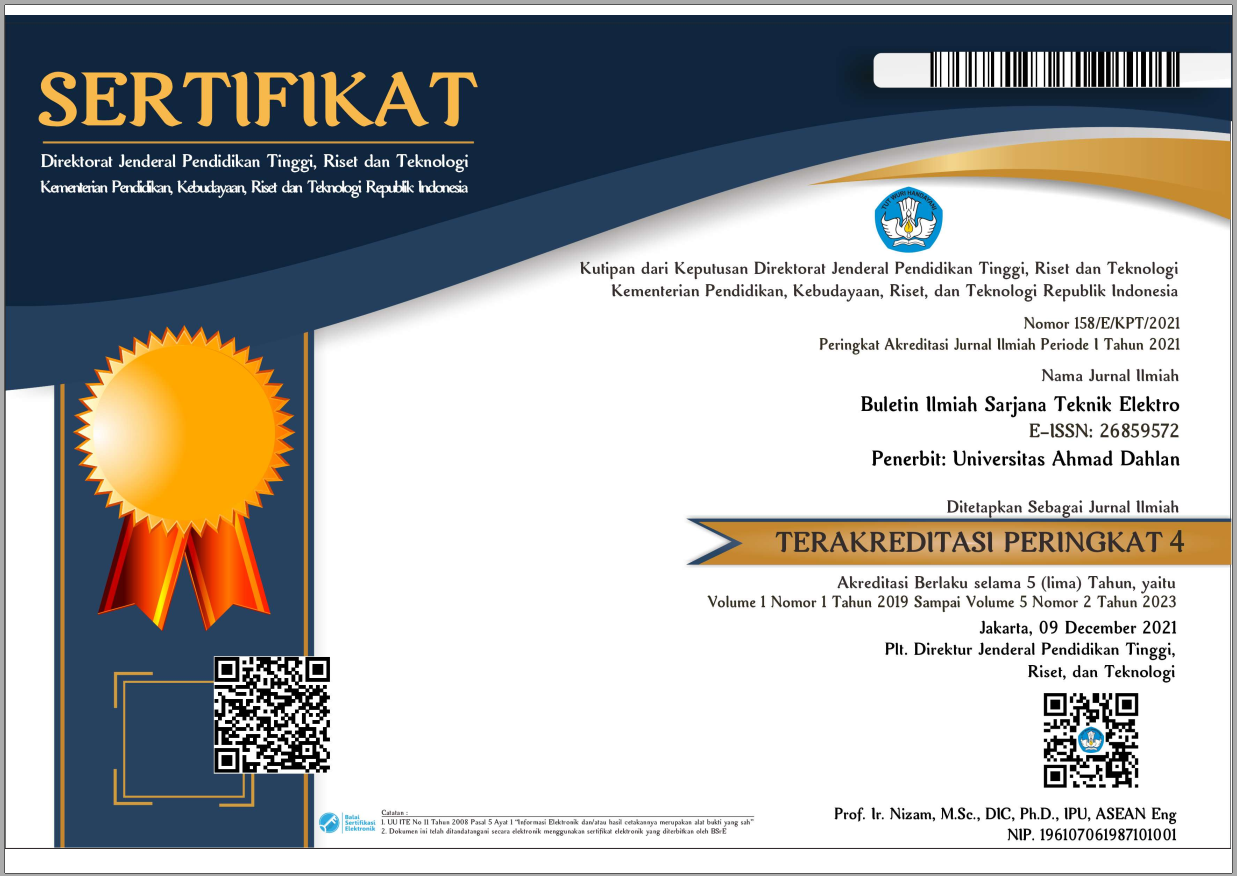The Stability of the Fixed Wings Unmanned Aircraft Using the PID Method at KRTI 2019
DOI:
https://doi.org/10.12928/biste.v5i2.6478Keywords:
Fixed Wings, PID, Pixhawk, Trial and Error, TunningAbstract
This study designed a UAV with an unmanned aircraft type with a Fixed Wings model that can perform the PID tunning process manually using the FBWA flight mode. An unmanned aircraft with the Fixed Wings type is designed to perform PID Roll tuning based on altitude and flight speed using the trial and error method increases the Proll value of 0.06 x 2 until the oscillation disappears and the final value of Proll is reduced by 50%. For the Iroll value, the increase in the value made is 0.1 x 2, increase it until it is sufficient and the final value of Iroll is reduced by 50%. For the Droll value, increase the value of 0.004 x 2 until the oscillation disappears and the final value of the Droll is reduced by 50%.
References
S. Wahyuni, M. I. Bahroni, and F. Umam, “Autonomous Fixed Wings Stability with PID Control,” International Conference on Science and Technology (ICST), pp. 527–531, 2018, https://doi.org/10.2991/icst-18.2018.110.
A. Bakar, L. Ke, H. Liu, Z. Xu, and D. Wen, “Design of Low Altitude Long Endurance Solar-Powered UAV Using Genetic Algorithm,” Aerospace, vol. 8, no. 8, p. 228, 2021, https://doi.org/10.3390/aerospace8080228.
A. T. Bayisa and G. Li-Hui, “Controlling quadcopter altitude using PID-control system,” International Journal of Engineering Research & Technology (IJERT), vol. 8, pp. 195-199, 2019, https://doi.org/10.17577/IJERTV8IS120118.
N. Dalwadi, D. Deb, and J. J. Rath, “Biplane Trajectory Tracking Using Hybrid Controller Based on Backstepping and Integral Terminal Sliding Mode Control,” Drones, vol. 6, no. 3, p. 58, 2022, https://doi.org/10.3390/drones6030058.
L. Bauersfeld, L. Spannagl, G. J. J. Ducard, and C. H. Onder, “MPC Flight Control for a Tilt-Rotor VTOL Aircraft,” IEEE Transactions on Aerospace and Electronic Systems, vol. 57, no. 4, pp. 2395-2409, 2021, https://doi.org/10.1109/TAES.2021.3061819.
E. Kuantama, T. Vesselenyi, S. Dzitac, and R. Tarca, “PID and Fuzzy-PID control model for quadcopter attitude with disturbance parameter,” International journal of computers communications & control, vol. 12, no. 4, pp. 519-532, 2017, https://doi.org/10.1109/DESSERT50317.2020.9124998.
K. Dergachov, S. Bahinskii, and I. Piavka, “The Algorithm of UAV Automatic Landing System Using Computer Vision,” 2020 IEEE 11th International Conference on Dependable Systems, Services and Technologies (DESSERT), pp. 247-252, 2020, https://doi.org/10.1109/DESSERT50317.2020.9124998.
N. Xuan-Mung and S.-K. Hong, “Improved Altitude Control Algorithm for Quadcopter Unmanned Aerial Vehicles,” Applied Sciences, vol. 9, no. 10, p. 2122, 2019, https://doi.org/10.3390/app9102122.
E. Bøhn, E. M. Coates, S. Moe, and T. A. Johansen, “Deep Reinforcement Learning Attitude Control of Fixed-Wing UAVs Using Proximal Policy optimization,” 2019 International Conference on Unmanned Aircraft Systems (ICUAS), pp. 523-533, 2019, https://doi.org/10.1109/ICUAS.2019.8798254.
B. Milan, M. Vasiljević-Toskić, M. Bodić, and V. Rajs, “Advantages of a combination of PD and PID controller over PID controller in the example of quadcopter control and stabilization,” International Journal of Electrical Engineering and Computing, vol. 4, no. 1, pp. 43–50, https://doi.org/10.7251/IJEEC2001043B.
C. Riecke et al., "Kontur-3: Human Machine Interfaces for Telenavigation and Manipulation of Robots from ISS," 2020 IEEE Aerospace Conference, pp. 1-10, 2020, https://doi.org/10.1109/AERO47225.2020.9172347.
S. Baldi, S. Roy, K. Yang, and D. Liu, “An Underactuated Control System Design for Adaptive Autopilot of Fixed-Wing Drones,” IEEE/ASME Transactions on Mechatronics, vol. 27, no. 5, pp. 4045-4056, 2022, https://doi.org/10.1109/TMECH.2022.3144459.
A. R. Kim, D. Shukla, A. Blevins, S. Keshmiri, and M. Ewing, “Validation and Verification of GNC for Large Fixed-Wing Unmanned Aerial System in Unstructured and Noisy Environment,” 2018 International Conference on Unmanned Aircraft Systems (ICUAS), pp. 1388-1397, 2018, https://doi.org/10.1109/ICUAS.2018.8453413.
C. Cömert and C. Kasnakoğlu, “Comparing and developing PID and sliding mode controllers for quadrotor,” International Journal of Mechanical Engineering and Robotics Research, vol. 6, no. 3, pp. 194-199, 2017, https://doi.org/10.18178/ijmerr.6.3.194-199.
A. Koubâa, A. Allouch, M. Alajlan, Y. Javed, A. Belghith, and M. Khalgui, “Micro Air Vehicle Link (MAVlink) in a Nutshell: A Survey,” IEEE Access, vol. 7, pp. 87658-87680, 2019, https://doi.org/10.1109/ACCESS.2019.2924410.
H. Arrosida and M. E. Echsony, “The Design of Optimal PID Control Method for Fixed Wings Movement Control,” Int J Artif Intell Res, vol. 2, no. 1, 2018, https://doi.org/10.29099/ijair.v2i1.32.
H. K. Tran and T. N. Nguyen, “Flight motion controller design using genetic algorithm for a quadcopter,” Measurement and Control, vol. 51, pp. 59-64, 2018, https://doi.org/10.1177/0020294018768744.
M. Rabah, A. Rohan, Y. J. Han, and S. H. Kim, “Design of fuzzy-PID controller for quadcopter trajectory-tracking,” International Journal of Fuzzy Logic and Intelligent Systems, vol. 18, pp. 204-213, 2018, https://doi.org/10.5391/IJFIS.2018.18.3.204.
Y. Sen and W. Zhongsheng, “Quad-Rotor UAV Control Method Based on PID Control Law,” 2017 International Conference on Computer Network, Electronic and Automation (ICCNEA), pp. 418-421, 2017, https://doi.org/10.1109/ICCNEA.2017.24.
L. Cedro and K. Wieczorkowski, “Optimizing PID controller gains to model the performance of a quadcopter,” Transportation Research Procedia, vol. 40, pp. 156-169, 2019, https://doi.org/10.1016/j.trpro.2019.07.026.
E. Paiva, J. Soto, J. Salinas, and W. Ipanaqué, “Modeling, simulation and implementation of a modified PID controller for stabilizing a quadcopter,” 2016 IEEE International Conference on Automatica (ICA-ACCA), pp. 1-6, 2016, https://doi.org/10.1109/ICA-ACCA.2016.7778507.
M. Talha, F. Asghar, A. Rohan, M. Rabah, and S. H. Kim, “Fuzzy Logic-Based Robust and Autonomous Safe Landing for UAV Fixed Wings,” Arabian Journal for Science and Engineering, vol. 44, pp. 2627–2639, https://doi.org/10.1007/s13369-018-3330-z.
J. J. Castillo-Zamora, K. A. Camarillo-GóMez, G. I. PéRez-Soto, and J. RodríGuez-ReséNdiz, “Comparison of PD, PID and Sliding-Mode Position Controllers for V–Tail Quadcopter Stability,” IEEE Access, vol. 6, pp. 38086-38096, 2018, https://doi.org/10.1109/ACCESS.2018.2851223.
M. O. Abdalla, S. Al-Baradie, “Real time optimal tuning of quadcopter attitude controller using particle swarm optimization,” J Eng Technol Sci., vol. 52, no. 5, 2020, https://garuda.kemdikbud.go.id/documents/detail/2702493.
F. A. A. Andrade et al., “Unmanned Aerial Vehicles Motion Control with Fuzzy Tuning of Cascaded-PID Gains,” Machines, vol. 10, no. 1, p. 12, 2021, https://doi.org/10.3390/machines10010012.

Downloads
Published
How to Cite
Issue
Section
License
Copyright (c) 2023 Pramudya Wisnujati, Son Ali Akbar

This work is licensed under a Creative Commons Attribution-ShareAlike 4.0 International License.
Authors who publish with this journal agree to the following terms:
- Authors retain copyright and grant the journal right of first publication with the work simultaneously licensed under a Creative Commons Attribution License that allows others to share the work with an acknowledgment of the work's authorship and initial publication in this journal.
- Authors are able to enter into separate, additional contractual arrangements for the non-exclusive distribution of the journal's published version of the work (e.g., post it to an institutional repository or publish it in a book), with an acknowledgment of its initial publication in this journal.
- Authors are permitted and encouraged to post their work online (e.g., in institutional repositories or on their website) prior to and during the submission process, as it can lead to productive exchanges, as well as earlier and greater citation of published work (See The Effect of Open Access).
This journal is licensed under a Creative Commons Attribution-ShareAlike 4.0 International License.



